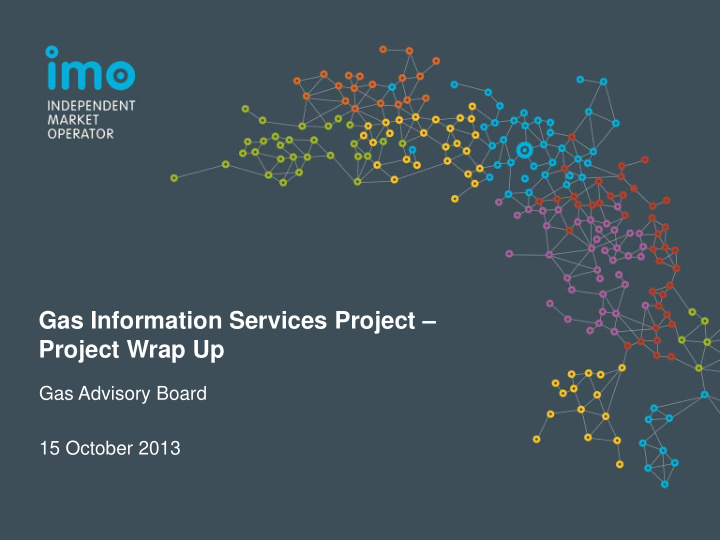



Gas Information Services Project – Project Wrap Up Gas Advisory Board 15 October 2013
Gas Services Information – a recap What are the GSI? A Gas Bulletin Board (GBB) – a public website showing near term forecasts of gas production, transmission, storage and use An Emergency Management Facility (EMF) – part of the GBB that will be activated in the event of an gas supply emergency to assist those managing the emergency A Gas Statement of Opportunities (GSOO) – an annual longer- term supply and demand forecast across all stages of the gas market supply-demand chain to identify potential constraints and opportunities for investment • To improve information transparency and facilitate the security, reliability, efficiency and competitiveness of the domestic gas supply market in WA. • IMO appointed by WA Government to implement and operate. 2
GSI Objectives (s6 of the Gas Services Information Act) • The objectives of the GBB and GSOO are to promote the long term interests of consumers of natural gas in relation to — (a) the security, reliability and availability of the supply of natural gas in the State; (b) the efficient operation and use of natural gas services in the State; (c) the efficient investment in natural gas services in the State; and (d) the facilitation of competition in the use of natural gas services in the State.
Primary Purpose (ss 4 and 5 of the GSI Act) • GBB is a website the primary purpose of which is to include information relating to short and near term natural gas supply and demand and natural gas transmission and storage capacity in the State. • GSOO is a periodic statement the primary purpose of which is to include information and assessments relating to medium and long term natural gas supply and demand and natural gas transmission and storage capacity in the State.
GISP Timeline
GISP Deliverables • Three key deliverables: GBB EMF GSOO • Other deliverables: GSI Rules and Procedures Other documents (GAB Constitution, Registration Forms) GBB Operational / Technical Documentation • Other priorities Focus on quality for users – useful information, user-friendly documents and website Developed in consultation with stakeholders
Process • Design Market Reform proposal Formal round of consultation – workshop and submissions • GSI Rules Two rounds of consultation – workshops and submissions Cost-benefit analysis (direct consultation with stakeholders) • GSI Procedures and GAB Constitution One round of consultation – workshop and submissions Draft Registration forms also available for comment
Process (continued) • GBB Development IT strategy developed – expert advice and consultation with AEMO Access to Intellectual Property in AEMO GBB Trial system available from June 2013 with draft user and technical documents • GSOO prepared Relied on public information and numerous discussions with individual stakeholders and peak bodies • GAB established December 2011 – met 11 times
Key Performance Indicators KPI Achieved? On time ≤ budget Forecast total spending ~$3million* ($3.3 million, including $350,000 seed funding $2.65million to be recovered through from PUO) fees over next 5 years GBB system cost $686,000 In consultation with stakeholders 4 rounds formal consultation 8 stakeholder forums 11 GAB meetings Other meetings/presentations Consistent with GSI Objectives * To be finalised at end calendar 2013 when IMO internal implementation is complete
Design Objectives # Principle Comment / examples 1 GIS Information – Current, Clear and Useful Considerable information published about forecast and actual production, transmission, storage and usage - GBB information published as close to real time as possible 2 Maximise Transparency of Information Justification provided for delay in publication of individual large user The publication of GIS Information should be facility consumption maximised, unless there is clear justification not to do so. 3 Maximise Symmetry and Equity of Information Information about the demand side Provision as well as the supply side 4 Benefit vs Effort in GIS Information Provision Pipeline capacity by pipeline (not and Publication Zone) Forecast pipeline flow data instead of user/producer forecasts
Design Objectives # Principle Comment/examples 5 Avoid Unnecessary Inconsistency with CSV files to upload Established Information Interfaces System Representation Information published both in aggregate 6 (Zone, usage categories) and individual The resolution of the GBB system facility representation should be sufficient to inform industry of gas flows, storage, and facility capabilities from processing plant to end users. Emergency Situations EMF developed to be activated in event 7 of emergency and support Westplan The GIS should complement and enhance framework industry and government emergency management processes and should present Daily GBB information to assist in emergency information data in a clear and identifying potential supply issues easily interpreted manner. 8 Cost Recovery IMO costs subject to ERA scrutiny The cost of operating the GIS should be Simple fee arrangements recovered in an administratively simple and cost-effective manner.
Feedback and usage • Generally positive feedback on both GBB and first GSOO • IMO welcomes suggestions for improvement • GBB All parties identified by the IMO are registered No significant operational issues Average daily visits ~ 40 • GSOO Relied on public information and information volunteered by participants Presented a supply-demand picture – attempted to look further than just processing capacity Forecasts considered somewhat optimistic Opportunity for discussion at next Agenda Item Future GSOOs – IMO can request information and GBB data available
Recommend
More recommend